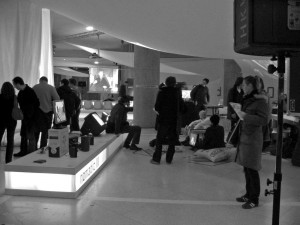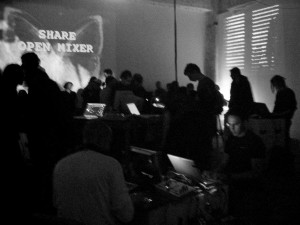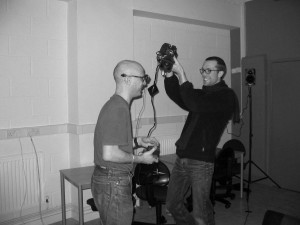The theme for Transmediale 04 was Fly Utopia—there is hope there is no hope. This offered interesting conceptual territory in terms of cultural theory and worried at the ongoing question as to the purpose and value of art, particularly digitally and electronically mediated art. Do the tools media artists use serve as formidable weapons in a techno-dystopic world, or do they allow us to escape into collective utopian imaginings?

Transmediale Workspace. Image: Gail Priest
Operating on a competition model the majority if content is drawn from nominated works in the categories of Image, Software and Interaction. Sound and audio video performance are the territory of Club Transmediale, which is an affiliated festival held at nightclub Maria am Ostbahnhof. Starting out as Videofest 17 years ago the screen focus is very strong. The competition attracted over 500 entries from which 8 thematic programs were developed. These were screened daily and were also set up in a video lounge as video on demand. As both an interdisciplinary sound artists and a director of Electrofringe, the screening program provided much inspiration with many of the more interesting abstract films, particularly in the Messages Received and Subtext Slides programs heavily reliant on the sound design as the foundation for the works. North Station by Ran Slavin (Israel) was a particularly excellent example with sound and footage drawn from the final transmissions from a contaminated Science station in Alaska.
The two day conference operated very much on the level of cultural and academic theory with sometimes only a passing mention of the subject of art. One exception was the Open Bodies, Mobile Bodies panel which featured a fascinating journey through the work of Fiona Raby working in the nexus between design and conceptual art. This was evidenced by the Bioland project on display in the exhibition in which products for the future were designed by a group of her postgraduate students at London’s Royal College of Art blending our fascination with technology, consumerism and immortality.

Share Open Mixer. Image: Gail Priest
Locative media seems to be the frontier at the moment and this was covered in the panel Mobilotopia, dealing with the passive and active modes of technological mobility and its pros and cons—you can go anywhere but you can also be tracked down anywhere. Trace by Teri Rueb (US) was an interesting example involving a trek through hiking trails with sonic episodes on the subject of memory and remembrance relayed via GPS (http://research.umbc.edu/~rueb/). This was also explored by the Xplo bus tour that was part of Club Transmediale, a sonic bus trip controlled by GPS which I was not able to experience. However I managed to catch a similar activity in my short stay in England in the form of a creative development involving Arnolfini and Mobile Bristol, in which soundartists, Daniel Belasco Rogers and Zoe Irvine created soundscapes triggered by locations around Bristol’s Queens Square investigating the finer levels of responsiveness and possibilities for intricate sound design using GPS technology. (http://www.mobilebristol.co.uk/arnolfini.html)
Due to the categorisations of Image Software and Screen, there is no category as such that deals with Sound as an entity unto itself. Much of this is covered, by Club Transmediale through it’s evening lineup of performances. There were also a series of panel discussions, however the club atmosphere and often poor moderation meant that these discussions, particularly the panel dealing with gender and its influence on electronic music was frustratingly unfocused and unilluminating. The fantastically articulate Terre Thaemlitz screened his DVD Love Bomb (at 3am) which illustrates his complex and erudite use of the audio visual medium as a site for political meaning and activation. Also of interest at Club Transmediale was the Open Mixer digital jam organised by US team Share which was a slickly organised mass audio visual jam over 2 nights in which anyone with mobile gear could plug and participate. Some of the results and certainly the atmosphere of mass creation was beautiful and inspiring. (http://share.dj/clubtransmediale/)

Christina Kubisch's installation. Image: Gail Priest
A highlight of the festival for me was De-Place/Re-Place bus tour. The audience was taken to four different locations and treated to site-based sound performances. Kaffe Matthews’ piece in the cellar of an old brewery was truly sublime. The escalating carnivorous nature of her sampling and resampling process caused every particle within the cavernous space to vibrate. The highlight of the night (and the festival for me) was the installation by Christina Kubisch which took place in the Research Institute for Water and Naval Engineering. The audience was invited to don gumboots and electromagnetic headphones and wade into an indoor channel of ankle deep water. At the other end was a beautiful loom of red wires that fanned out and into the water. As you walked along you began to pick up various hums and distant voices: each wire was transmitting a text around shipping and navigation. You could mix your own sonic experience by zigzagging across the wires, changing proximity to the loom for intensity. It was a stunning work in its integration of sonic, visual, and physical elements.
The other sonic highlight was to be found in the work space—an kind of market place/inhabitation for invited collectives—in the foyer for Haus der Kulturen der Welt. Entering a small cubicle made of fabric 10 speakers were strapped to particular pressure points over the head and spine, backs of knees, feet. A multitrack soundpiece was then literally played through the whole body. This was a welcome physical manifestation in a festival that I often felt had lost track of the flesh within all the technology.
Attending Transmediale also meant that I was able to coordinate other activities in Berlin, such as a presentation of my work at the Elektronishes Musik Hoeren, a weekly listening salon at the Teknishen Universität. It was an interesting experience to run through the chronology of my work to date, as it laid bare for both the listeners and myself the still evolving aesthetic as influenced by developments with in the Australian sound scene. It was certainly a pleasure to be able to play excerpts from my 5.1 installation Sonic Salon, in the superbly equipped 10 speaker sound studio. This was made possible through the Marije Baalman, who had attended Electrofringe in 2003 and is a masters student at TU developing her soundfield synthesis syystems for spatial audio. Baalman also gave me the opportunity to perform a live set, with French artist Mangrove Kipling on the trial radio station reboot FM that was taking the otherwise pop FM-radio besieged Berlin by storm. (http://www.reboot.fm)

Alex Bradley & Duncan Speakman. Image: Gail Priest
As well as investigating opportunities in Berlin, the trip also made it possible to work with sound artists Alex Bradley (22,0000 Points of Light) and Charlie Poulet on a creative development and weekend residency at the Engine Room in Bridgport UK. The project Whiteplane was seeded in a 4 hour installation for surround sound and architectural lighting that was first presented at Arnolfini in Bristol. This phase was looking at the use of video glasses, with quadraphonic sound, playing with the reversal of intimate sources (eg headphones vs video glasses) As I have rarely worked with other sound artists, mainly collaborating with performers and videomakers, the knowledge and experience gained was invaluable. This development continued in Sydney in early March with a small showing at Performance Space Sydney, and we are planning further virtual collaborations.
On top of these activities I was also able to take in a plethora of exhibitions such as the Berlin Biennale, Poes1s. Digitale Poesie a fantastic exhibition centred around text and digital media (http://www.p0es1s.net), and a trip to Karlsruhe allowed me to experience over 60 seminal video works at ZKM as part of the Goetz Sammlung and Temporal Values. This on top of attending Transmediale was invaluable not only as it allowed me to see first hand what work people from around the world were developing, it also allowed me to contextualise the work that Australian new media artists. As I also had the opportunity to present an Electrofringe screening program, Alterna Terra Zones it allowed me to investigate opportunities with other festivals and organisations and develop vital contacts with artist and curators which will have a significant effect on my practice as a sound & installation artists, curator and active member of the media arts community.
Gail Priest
Read More
 This work is licensed under a Creative Commons Attribution-NonCommercial-ShareAlike 3.0 Australia.
This work is licensed under a Creative Commons Attribution-NonCommercial-ShareAlike 3.0 Australia.






